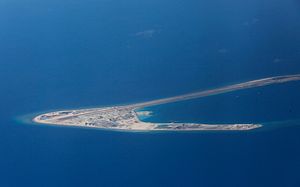Are China’s seven artificial islands in the Spratly Group in the South China Sea liable to complicate U.S. freedom of maneuver in a conflict in East Asia? In a recent article at War on the Rocks, Gregory Poling makes the case that the islands have “considerable military value for Beijing,” contrary to some conventional wisdom that has written off the value of these facilities in a conflict.
Poling’s argument is a convincing corrective to the conventional wisdom that these facilities — built on top of reclaimed land and quickly too — would be a strategic liability for Beijing in a conflict. In peacetime, these outposts serve to allow China coercive leverage as it bolsters its “nine-dash line” claim in the South China Sea, where the Philippines, Malaysia, Vietnam, Brunei, and Taiwan maintain territorial claims (and Indonesia maintains a disputed exclusive economic zone claim).
But in a conflict, the capabilities on the Spratly outposts are more than just cannon fodder. They will contribute to Chinese firepower, situational awareness, and logistics. Beijing is also well-positioned to employ anti-ship and anti-air missiles on these facilities to deny access to the U.S. Navy and other regional navies.
Separately, even the ability of the People’s Liberation Army Air Force to sustain operations off these facilities in a crisis would be difficult for the United States to challenge. Poling writes, citing the U.S. cruise missile strike on Syria’s Shayrat Air Base in 2017, that China would find it possible to reconstitute these airstrips not long after an initial conventional strike.
Finally, given the size of certain facilities — notably Mischief and Subi Reefs — even long-range conventional precision strike requirements for the United States would be substantial. To fully degrade the ability of these islands to serve as useful basing points for the People’s Liberation Army Navy and possibly even the PLA Rocket Force in the future, the U.S. would need a lot of firepower — perhaps more than is realistic.
One angle that Poling doesn’t explicitly raise is the value of China’s Spratly outposts — and Woody Island in the Paracels — in serving as the frontier of Beijing’s burgeoning South China Sea ballistic missile submarine bastion.
Long concerned about the survivability of its land-based nuclear forces, in a crisis, China would seek to flush out its Type 094 nuclear-powered ballistic missile submarines into the South China Sea and, if nuclear retaliation against the United States were to become necessary, seek to penetrate the first island chain to launch its JL-2 submarine-launched ballistic missiles (these missiles lack sufficient range to hit U.S. homeland targets from the South China Sea itself).
The Spratly outposts can contribute substantially to Beijing’s ability to not only deny maneuver to the U.S. Navy in the South China Sea, thereby enhancing the survivability of deployed SSBNs in a crisis, but also serve as a staging area for anti-submarine warfare operations aimed at detecting and denying access to U.S. undersea surveillance assets, including submarines and autonomous underwater vehicles.
China’s artificial islands have for too long been taken as the physical manifestation of Beijing’s irredentism and revisionism in the South China Sea and while their primary purpose may be the assertion of dubious sovereignty claims, they’re more likely than not to be a serious capability in wartime. It’s past time for the conventional wisdom on the South China Sea to take this seriously.

































